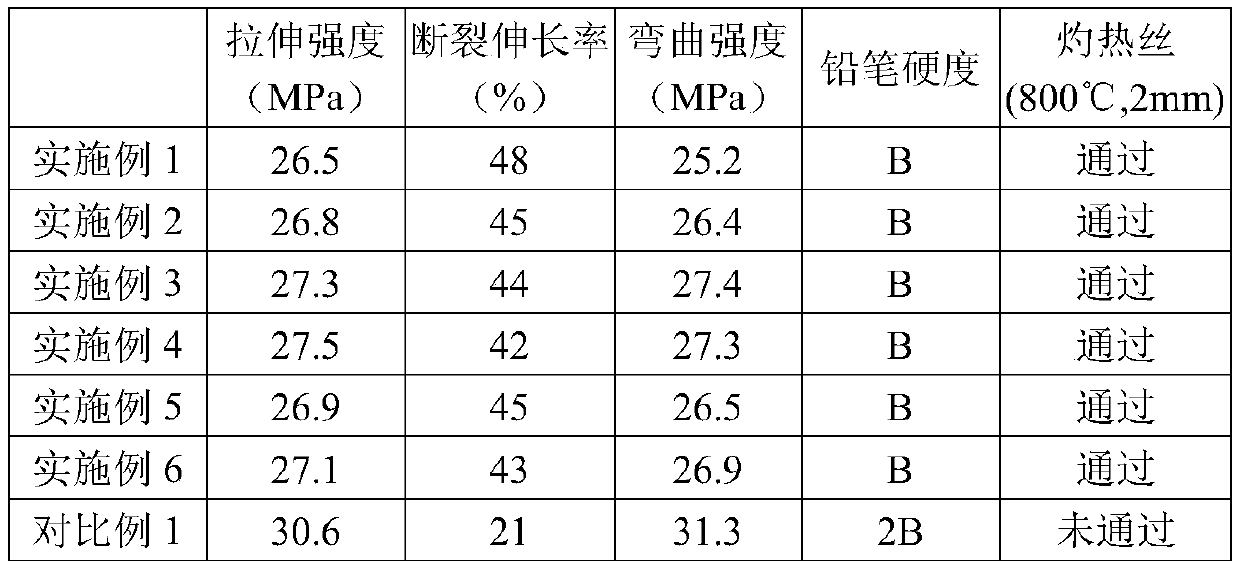Scratch-resistant flame-retardant PP modified material and preparation method thereof
A modified material and scratch-resistant technology, which is applied in the field of polymer materials, can solve the problems of failing the 750°C glow wire or needle flame test, soft surface of PP materials, and decreased flame retardancy, so as to improve the scratch resistance , good overall performance, good elastic recovery performance
- Summary
- Abstract
- Description
- Claims
- Application Information
AI Technical Summary
Problems solved by technology
Method used
Image
Examples
Embodiment 1
[0025] The preparation of a scratch-resistant and flame-retardant PP modified material includes the following steps:
[0026] Step 1, in parts by mass, 45 parts of block copolymerized polypropylene, 15 parts of random copolymerized polypropylene, 5 parts of nano-alumina and polypropylene grafted high molecular weight polyorganosiloxane, acrylic acid-polysiloxane 2 parts of rubber-methyl methacrylate multi-polymer and acrylic acid-ethylene-propylene rubber-methyl methacrylate multi-polymer, 4 parts of silicon gel microencapsulated ammonium polyphosphate, graphene and magnesium aluminum double hydroxide Add 1.5 parts of doped nanomaterials, 2 parts of zinc stearate and 1.5 parts of tetrakis[β-(3,5-di-tert-butyl-4-hydroxyphenyl) propionate] pentaerythritol ester into the mixer, Stir and mix at 600 rpm to obtain a mixture;
[0027] Step 2: Add the mixture obtained in Step 1 into a twin-screw extruder, melt and mix at a temperature of 195-220°C, and then granulate, cool, dry, and ...
Embodiment 2
[0029] The difference from Example 1 is the composition of the PP modified material: 35 parts of block copolymerized polypropylene, 10 parts of random copolymerized polypropylene, 3 parts of nano-alumina and polypropylene grafted high molecular weight polyorganosiloxane, acrylic acid - 1 part of polysiloxane rubber-methyl methacrylate multi-polymer, 2 parts of polyurethane microencapsulated ammonium polyphosphate, 2 parts of nickel-aluminum double hydroxide doped nanomaterials, 1 part of silicone powder and disulfide Dilauryl propionate 1 part.
[0030] The rest are the same as in Embodiment 1, and will not be repeated here.
Embodiment 3
[0032] The difference from Example 1 is the composition of the PP modified material: 40 parts of block copolymerized polypropylene, 12 parts of random copolymerized polypropylene, 4 parts of nano-alumina and polypropylene grafted high molecular weight polyorganosiloxane, acrylic acid - 3 parts of ethylene propylene rubber-methyl methacrylate multi-component copolymer, 3 parts of melamine resin microencapsulated ammonium polyphosphate, 1.8 parts of graphene and zinc aluminum double hydroxide doped nanomaterials, 2 parts of hydroxyl silicone oil and 4 parts , 1 part of 4'-thiobis(6-tert-butyl-3-methylphenol).
[0033] The rest are the same as in Embodiment 1, and will not be repeated here.
PUM
 Login to View More
Login to View More Abstract
Description
Claims
Application Information
 Login to View More
Login to View More - R&D
- Intellectual Property
- Life Sciences
- Materials
- Tech Scout
- Unparalleled Data Quality
- Higher Quality Content
- 60% Fewer Hallucinations
Browse by: Latest US Patents, China's latest patents, Technical Efficacy Thesaurus, Application Domain, Technology Topic, Popular Technical Reports.
© 2025 PatSnap. All rights reserved.Legal|Privacy policy|Modern Slavery Act Transparency Statement|Sitemap|About US| Contact US: help@patsnap.com


